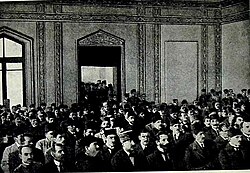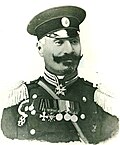Azerbaijan Democratic Republic
The Azerbaijan Democratic Republic (ADR) also known as Azerbaijan People's Republic was the first successful attempt to create a democratic and secular republic in the Muslim world before the Republic of Turkey.[4] It was founded on May 28, 1918 after the collapse of the Russian Empire that began with the Russian Revolution of 1917 by the Azerbaijani National Council in Tiflis, Georgia.[5] Its borders were with Russia in the north, Democratic Republic of Georgia in the north-west, Democratic Republic of Armenia in the west, and Persian Empire (Iran) in the south. It had a population of 2.86 million.[6] Ganja was the temporary capital of the Republic as Baku, which is the de jure capital, was under Bolshevik control.
Azerbaijan Democratic Republic Azərbaycan Xalq Cümhuriyyəti | |||||||||
|---|---|---|---|---|---|---|---|---|---|
| 1918–1920 | |||||||||
| Motto: | |||||||||
 Map of Azerbaijan including disputed territories with Armenia and Georgia issued in Baku for Paris Peace Conference in 1919. | |||||||||
| Capital | Ganja (until Sep 1918) Baku | ||||||||
| Common languages | Azerbaijani | ||||||||
| Government | Parliamentary republic | ||||||||
| Prime Minister | |||||||||
• 1918–1919 | Fatali Khan Khoyski | ||||||||
• 1919–1920 | Nasib bey Yusifbeyli | ||||||||
• 1920 | Mammad Hasan Hajinski | ||||||||
| Speaker | |||||||||
• 1918 | Mahammad Amin Rasulzade | ||||||||
• 1918–1920 | Alimardan bey Topchubashi | ||||||||
| Historical era | Interwar period | ||||||||
• | 28 May 1918 | ||||||||
• | 28 April 1920 | ||||||||
| Area | |||||||||
| 1918[1][2] | 99,908.87 km2 (38,575.03 sq mi) | ||||||||
| Population | |||||||||
• 1918[3] | 2862000 | ||||||||
| Currency | Azerbaijani manat | ||||||||
| ISO 3166 code | AZ | ||||||||
| |||||||||
| Today part of | |||||||||
Under the ADR, the government was a parliamentary system in which a parliament, called the Milli Majlis (National Assembly of Azerbaijan) elected on the basis of universal, free, and proportional representation, was the highest political institution of state authority and the Council of Ministers was responsible before it. Fatali Khan Khoyski became its first prime minister.[7] Besides the political party Musavat which had the majority in parliament, other political parties were Ehrar, Ittihad, Muslim Social-democrats as well as representatives of Armenian (21 out of 120 seats[5]), Russian, Polish, Jewish and German minorities[8] gained seats in the parliament. Some members supported Pan-Islamist and Pan-Turkist ideologies.[9]
Among the important accomplishments of the parliament was to give women the right to vote, making Azerbaijan the first Muslim nation to give women equal political rights with men.[5] Azerbaijan made these reforms earlier than the United Kingdom and the United States. Another important accomplishment of ADR was the establishment of Baku State University, which was the first modern-type university founded in Azerbaijan.
End of the Democratic Republic of Azerbaijan, 1920
By March 1920, it became clear that Soviet Russia would attack and invade Azerbaijan. The Soviet Bolshevik leader Vladimir Lenin said that the invasion was justified by the fact that Soviet Russia could not survive without the Baku oil fields, which was at that time the largest oil field in the world with more than half of the world's oil reserves.[10][11] According to the common opinion in Moscow, Russian Bolsheviks were to "help" the Baku proletariat (workers) in overthrowing the "counter-revolutionary nationalists", meaning the government and the Azerbaijan Democratic Republic.
After a major political crisis, the Fifth Cabinet of Ministers of the Azerbaijan Democratic Republic resigned on April 1, 1920. On April 25, 1920, the Soviet Russian 11th Red Army crossed into Azerbaijan, entering Baku on April 27. They demanded the closing of the Azerbaijani parliament and set up their own Bolshevik government headed by Nariman Narimanov. To avoid bloodshed, the members of parliament had to agree with the demand and the ADR officially ended on April 28, 1920, giving way to the Azerbaijan Soviet Socialist Republic as its successor state. The Red Army met very little resistance in Baku from the Azerbaijani army, which was tied up on the Karabakh front. The first Communist government of Azerbaijan consisted almost entirely of native Azerbaijanis from the left-wing political factions of the Hummat and Adalat political parties.[12]
In May 1920, there was a major rebellion against the occupying Soviet Russian 11th Red Army in Ganja. People wanted to restore the Musavatists to power. The rebellion was crushed by government troops by May 31. Leaders of the ADR either fled to the Democratic Republic of Georgia, which was the last independent Caucasian country that was invaded in 1921 by Soviet Russia, then to Turkey and Iran, or were captured by Bolsheviks, like Mammed Amin Rasulzade, who was later allowed to emigrate, or were executed (killed) like Gen. Selimov, Gen. Sulkevich, Gen. Agalarov, a total of over 20 generals,[13] or assassinated by Armenian terrorists like Fatali Khan Khoyski and Behbudagha Javanshir.[14] Most students and citizens travelling abroad remained in those countries, never to return again to their country. Other important ADR military leaders like the former Minister of Defense General Samedbey Mehmandarov and deputy defense minister General Ali-Agha Shikhlinski (who was called "the God of Artillery" ) were at first arrested, but released two months later thanks to efforts of Nariman Narimanov. Gen. Mehmandarov and Gen. Shikhlinsky spent their last years teaching in the Azerbaijan SSR military school.
In the end, "the Azeris did not surrender their brief independence of 1918-20 quickly or easily. As many as 20,000 died resisting what was effectively a Russian reconquest."[15] However, the founding of the Azerbaijan Soviet Socialist Republic was made easier by the fact that there was a certain popular support for Bolshevik ideology in Azerbaijan, among the industrial workers in Baku.[16]
Azerbaijan Democratic Republic Media
A founder and Speaker of the Republic, Mammad Amin Rasulzade is widely regarded as the national leader of Azerbaijan.
Memorial plaque on the wall of the hall of the building in Tbilisi, where on May 28, 1918, the Azerbaijani National Assembly declared the first independent Azerbaijan Democratic Republic
Office of the Ukrainian Mission and Ukrainian National Council in the House of Mirzabeyov brothers on Nikolayevskaya Str, 8
Ali-Agha Shikhlinski was a Lieutenant-General of the Imperial Russian Army and the Deputy Minister of Defense and General of the Artillery of the Azerbaijan Democratic Republic.
Samad bey Mehmandarov was a General of the Artillery in Imperial Russian Army before becoming the Azerbaijan Democratic Republic's Minister of Defense.
Related pages
References
- ↑ "93 years pass since establishment of first democratic republic in the east – Azerbaijan Democratic Republic". Azerbaijan Press Agency. Retrieved May 28, 2011.
- ↑ Balayev, Aydin; Aliyarov, Suleiman; Jafarov, Jafar (1990). Азербайджанское национально-демократическое движение. 1917-1920 гг [Azerbaijani National Democratic Movement]. Elm. p. 92. ISBN 5-8066-0422-5.
- ↑ Isgenderli, Anar (2011). Realities of Azerbaijan 1917-1920. Xlibris Corporation. p. 196. ISBN 978-1-4568-7953-2.
- ↑ Tadeusz Swietochowski. Russia and Azerbaijan: A Borderland in Transition. Columbia University Press, 1995. ISBN 0231070683, 9780231070683 and Reinhard Schulze. A Modern History of the Islamic World. I.B.Tauris, 2000. ISBN 1860648223, 9781860648229. Citations are at Talk:Azerbaijan Democratic Republic#First or second.
- ↑ 5.0 5.1 5.2 Kazemzadeh, Firuz (1951). The Struggle for Transcaucasia: 1917-1921. The New York Philosophical Library. pp. 124, 222, 229, 269–270. ISBN 0-8305-0076-6.
- ↑ Tadeusz Swietochowski. Russian Azerbaijan, 1905-1920: The Shaping of a National Identity in a Muslim Community. Cambridge University Press, 2004, p. 129. ISBN 0521522455
- ↑ La Chesnais, Pierre Georget (1921). Les peuples de la Transcaucasie pendant la guerre et devant la paix. Éditions Bossard. pp. 108–110.
- ↑ "Azerbaijan:History". Archived from the original on 2007-03-15. Retrieved 2011-11-28.
- ↑ Musavat Party (Azerbaijan)
Pan-Turkism: From Irrendentism to Coopersation by Jacob M. Landau P.55
On the Religious Frontier: Tsarist Russia and Islam in the Caucasus by Firouzeh Mostashari P. 144
Ethnic Nationalism and the Fall of Empires by Aviel Roshwald, page 100
Disaster and Development: The politics of Humanitarian Aid by Neil Middleton and Phil O'keefe P. 132
The Armenian-Azerbaijan Conflict: Causes and Implications by Michael P. Croissant P. 14 - ↑ Lenin and Caucasus oil Archived 2003-09-06 at the Wayback Machine on GlobalRus.ru (in Russian)
- ↑ Deliveries of Baku oil to Russia in April-May 1920 "History of the City of Baku" (in Russian)
- ↑ Richard Pipes. The Formation of the Soviet Union: Communism and Nationalism 1917-1923, pp 218-220, 229 (Cambridge, Massachusetts, 1997).
- ↑ List of Azerbaijani Generals and Admirals, Military Leaders and Heroes, May 2006
- ↑ "The Fate of some of the ADR Parliament Members", Azerbaijan International (7.3) Autumn 1999
- ↑ Hugh Pope, "Sons of the conquerors: the rise of the Turkic world", New York: The Overlook Press, 2006, p. 116, ISBN 1-58567-804-X
- ↑ Svante Cornell. "Undeclared War-The Nagorno-Karabakh Conflict Reconsidered", Journal of South Asian and Middle Eastern Studies, vol. 20, no. 4, Fall 1997










